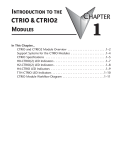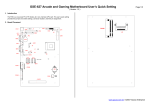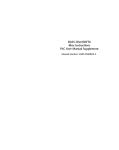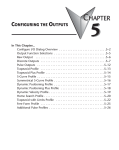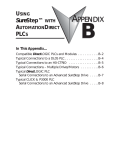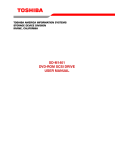Download Chapter 4 - AutomationDirect
Transcript
CONFIGURING THE INPUTS CHAPTER 4 In This Chapter... Configure I/O Dialog Overview . . . . . . . . . . . . . . . . . . . . . . . . . . . .4–2 Input Function Selections . . . . . . . . . . . . . . . . . . . . . . . . . . . . . . . .4–5 Counter . . . . . . . . . . . . . . . . . . . . . . . . . . . . . . . . . . . . . . . . . . . . .4–6 Quadrature Counter . . . . . . . . . . . . . . . . . . . . . . . . . . . . . . . . . . . .4–7 Pulse Catch . . . . . . . . . . . . . . . . . . . . . . . . . . . . . . . . . . . . . . . . . . .4–8 Edge Timer . . . . . . . . . . . . . . . . . . . . . . . . . . . . . . . . . . . . . . . . . . .4–9 Dual Edge Timer . . . . . . . . . . . . . . . . . . . . . . . . . . . . . . . . . . . . . .4–10 Reset 1 and Reset 2 (Hard Resets for Counters Only) . . . . . . . . . . .4–11 Soft Resets . . . . . . . . . . . . . . . . . . . . . . . . . . . . . . . . . . . . . . . . . .4–11 Capture 1 . . . . . . . . . . . . . . . . . . . . . . . . . . . . . . . . . . . . . . . . . . .4–12 Inhibit 1 . . . . . . . . . . . . . . . . . . . . . . . . . . . . . . . . . . . . . . . . . . . .4–12 Introduction to the Scaling Wizard . . . . . . . . . . . . . . . . . . . . . . . .4–13 Chapter 4: Configuring the CTRIO Inputs 1 2 3 4 5 6 7 8 9 10 11 12 13 14 A B C D Configure I/O Dialog Overview 4–2 The Configure I/O dialog is the location where input and output functions are assigned to the module. The choice of input and output functions determines which options are available. The input and output function boxes prompt you with selections for supported functions. The configuration software disallows any unsupported selections. For DirectLOGIC users, from the main CTRIO Workbench window, click on the “Go to PROGRAM Mode” button (if in RUN Mode). Then, click on the “Config I/O” button to arrive at a dialog shown below. Notice that the window has a tab for each input Channel. NOTE: You don’t have to be in PROGRAM mode to enter the Configure I/O dialog, however you must be in PROGRAM mode to save the configuration to the CTRIO module. H2, H4, T1H-CTRIO, H2-CTRIO2 Configure I/O Dialog H0-CTRIO(2) Configure I/O Dialog Counter I/O User Manual, 2nd Ed., Rev. D Chapter 4: Configuring the CTRIO Inputs For Do-more users, the Workbench options have been built into the Do-more Designer software. The configuration dialog is found by first opening the System Configuration window by selecting the “XY Configure” button in the main toolbar. With the System Configuration page open, select the Module Configuration(s) page from the lefthand column. On this page, highlight the desired CTRIO module and click Edit Config. Counter I/O User Manual, 2nd Ed., Rev. D 1 2 3 4 5 6 7 8 9 10 11 12 13 14 A B C D 4–3 Chapter 4: Configuring the CTRIO Inputs 1 2 3 4 5 6 7 8 9 10 11 12 13 14 A B C D 4–4 Now the Edit CTRIO/CTRIO2 Configuration window should be open, click the “Configure I/O...” button. You should now have the Configure I/O window open, similar to the one shown here, with a tab for each input Channel. The input options are listed by function. Four boxes labeled A, B, C, and D correspond to the input terminals on the face of the module (1A-1D or 2A-2D; A-D for the H0CTRIO(2)). The Output functions are listed as 0, 1, 2, and 3. These numbers correspond to the markings beside the module’s output terminals (Y0-Y3; Y0Y1 for the H0-CTRIO(2)). Counter I/O User Manual, 2nd Ed., Rev. D Chapter 4: Configuring the CTRIO Inputs For DirectLOGIC users, be sure to write the changes to the module from Workbench when the configuration is complete. For example, you might click on “Counter” in the “A” box, then OK to return to the main Workbench window. Once you arrive back at the main window, you must click “Write Module” to save your selection to the module. The module will need to be in Program Mode to perform the Write Module operation. If you do not perform the Write Module operation (or a Write File operation) your configuration will be lost upon quitting Workbench. This applies to all changes to the module configuration. For Do-more users, the “Write Module” button does not exist because the Module Configuration dialog stores the CTRIO's configuration as a permanent part of the Do-more controller's System Configuration. Input Function Selections Supported Functions The input channels offer the same configuration options. The module supports five primary input functions: • Counter • Quadrature Counter • Pulse Catch • Edge Timer • Dual Edge Timer Each of the primary functions uses one or two input terminals for making connections to field devices (plus a common). Combinations of the listed functions are possible. The configuration dialog disallows any unsupported configurations. Three secondary input functions are also supported: • Reset • Capture • Inhibit Each secondary input modifies the primary input functions in some way and uses one input terminal. (Limit Out 0 and Limit Out 2 input functions are only available for use when the outputs are set to pulse output mode). Discrete Outputs Pre-Assigned to Input Functions CTRIO discrete outputs can be assigned to the Counter, Timer and Pulse Catch input functions within the Configure I/O dialog. The outputs respond to presets assigned by the user in the Preset Tables dialog. The presets are assigned based on the scaled value of an input, or the raw value if it has no scaled value. The CTRIO’s four outputs can all be assigned to one function, or they can be grouped within functions and within channels in any manner selected by the user. See Chapter 5 for more information on using Preset Tables. Counter I/O User Manual, 2nd Ed., Rev. D 1 2 3 4 5 6 7 8 9 10 11 12 13 14 A B C D 4–5 Chapter 4: Configuring the CTRIO Inputs 1 2 3 4 5 6 7 8 9 10 11 12 13 14 A B C D Counter Function 4–6 The CTRIO module supports up or down counting using single-ended encoders (or other single-ended pulse sources) as inputs. Encoders, proximity A sensors, etc., can be connected to input A and/or input B on either channel or both channels. The C and D inputs are available to modify the A and B inputs. The C and D inputs can be used for Reset, Inhibit, or Capture. These functions are explained later in this chapter. The CTRIO discrete output(s) can be assigned to the Counter function using the Preset Tables dialog. Refer to “Creating and Using the Output Tables” section in Chapter 5 for details. 1A 2A 1B 2B 1C 2C 1D 2D 1M 2M NC C2 C0 Y2 NOTE: To insure proper operation, the field device wiring and the configuration must be compatible. For wiring information see Chapter 2. Y0 C3 C1 Y3 Y1 The module’s four input terminals are represented by the A, B, C, and D boxes on the left side of this dialog. If you are wiring your counter input to terminal 1A, you will want to select the Channel 1 tab near the top of this window and click “Counter” in box A. At this point, you have four decisions to make regarding your input at 1A. 1. Select count up or count down. A button, in the Function 1 box, toggles between Up and Down counting. Click the button labeled “Up” (or “Down”) to see the change to the opposite count direction. 2. Each input pulse is counted, but you are free to designate whether you want the count to register on the rising edge of the pulse, the falling edge, or both. The button with the graphical representation of a pulse toggles between these choices. 3. The Reset value is assigned by clicking and typing a value in the data input field. This value is for hardwired resets. When the hardwired reset is activated, the count value returns to the reset value. 4. The last remaining decision to be made is about scaling. Clicking the button with the ruler symbol starts the Scaling Wizard. We discuss the scaling wizard later in this chapter. The Scaling Wizard is intelligent in that it offers scaling options that are appropriate for your input selections. Counter I/O User Manual, 2nd Ed., Rev. D Chapter 4: Configuring the CTRIO Inputs Quad Counter The CTRIO module supports quadrature counting using quadrature encoders as inputs. Connect your encoder to input A and input B on either channel. A second quadrature encoder can be connected to the other channel. The C and D inputs are available to control the quadrature input counting. The C and D inputs can be used for Reset, Inhibit, or Capture. These functions are explained later in this chapter. The CTRIO discrete output(s) can be assigned to the Quad Counter function using the Preset Tables dialog. Refer to “Creating and Using the Output Tables” section in Chapter 5 for details. 1A A 2A 1B B 2B 1C 2C 1D 2D 1M 2M NC C2 C0 Y2 Y0 C3 C1 Y3 Y1 NOTE: To insure proper operation, the field device wiring and the configuration must be compatible. For wiring information see Chapter 2. Notice that the module’s four input terminals are represented by the A, B, C, and D boxes on the left side of this dialog. If you are wiring your quadrature counter inputs to terminal 1A and 1B, you will need to select the Channel 1 tab near the top of this window and click “Quad Counter” in box A. Notice that input B is now slaved to input A. At this point, you have three decisions to make regarding your quadrature input. 1. A multiplier can be applied to the quadrature input to increase its resolution. Select “1x”, “2x”, or “4x.” [1X = pulses processed on leading edge of input A, 2X = pulses are processed on both edges of input A, 4X = pulses processed on both edges of input A and both edges of input B.] 2. The “Reset Value” is assigned by clicking in the data input field and typing in a value. When the count is reset, using any of the reset methods, the count value returns to the Reset Value. The reset options are described in more detail later in this chapter. 3. The last remaining decision to be made is about scaling. Clicking the button with the ruler symbol starts the Scaling Wizard. The Scaling Wizard is intelligent in that it offers only those scaling options that are appropriate for your input selections. We discuss the scaling wizard in greater detail later in this chapter. Counter I/O User Manual, 2nd Ed., Rev. D 1 2 3 4 5 6 7 8 9 10 11 12 13 14 A B C D 4–7 Chapter 4: Configuring the CTRIO Inputs 1 2 3 4 5 6 7 8 9 10 11 12 13 14 A B C D Pulse Catch 4–8 The CTRIO “Pulse Catch” function allows a very short duration pulse to be qualified and lengthened to a time period long enough to guarantee that it is seen by the CPU. CPU scans necessarily vary with the length and complexity of the user’s program. A scan frequency of several milliseconds, or more, is common. A pulse that lasts less than one millisecond, is typically hard to catch during the CPU scan. The CTRIO module’s Pulse Catch function sees the fast incoming signal and holds its status in a status bit until the CPU can see it. A discrete output(s) can also be tied to follow the Pulse Catch input. NOTE: To insure proper operation, the field device wiring and the configuration must be compatible. For wiring information see Chapter 2. Notice that the module’s four input terminals are represented by the A, B, C, and D boxes on the left side of this dialog. If you are wiring your input to terminal 1C, you will need to select the Channel 1 tab near the top of this window and click Pulse Catch in box C. Three selections must be made in conjunction with the Pulse Catch option. 1. First, a decision must be made whether to look for the rising edge of the pulse or the falling edge of the pulse. This is a critical decision. Careful attention should be paid to the type of output the field device generates. If the signal voltage is normally low, but a short duration pulse sends the signal to the ON state, you will want to trigger off the rising edge, and vice versa. 2. The second decision you will need to make is the minimum pulse width you want to capture. Transients below this width will not be recorded. Set this value by typing the desired value in the “Minimum Width In” field. 3. The final decision to be made is the length of pulse the CTRIO module should send in response to the input pulse. Make this setting by typing in the desired value in the “Pulse Out Width” field. 1A 2A 1B 2B 1C 2C 1D 2D 1M 2M NC C2 C0 Y2 Y0 C3 C1 Y3 Y1 Counter I/O User Manual, 2nd Ed., Rev. D n + 20.8 status bit D Chapter 4: Configuring the CTRIO Inputs Edge Timer The Edge Timer measures the time from the rising edge of one pulse to the rising edge of the next pulse, or the rising edge of one pulse to the falling edge of the same pulse, or the falling edge of one pulse to the falling edge of the next pulse. Encoders, proximity sensors, etc., can be connected to input C and/or input D on either channel or both channels. The CTRIO discrete output(s) can be assigned to the Timer function using the Preset Tables dialog. Refer to “Creating and Using the Output Tables” section in Chapter 5 for details. 1A 2A 1B 2B 1C C 2C 1D 2D 1M 2M NC C2 C0 Y2 Y0 C3 NOTE: To insure proper operation, the field device wiring and the configuration must be compatible. For wiring information see Chapter 2. C1 Y3 Y1 Notice that the module’s four input terminals are represented by the A, B, C, and D boxes on the left side of this dialog. If you are wiring your input to terminal 1C, you will need to select the Channel 1 tab near the top of this window and click Edge Timer in box C. At this point, you have four decisions to make regarding your input at 1C. 1. First, designate the pulse edges you want to measure between. There are four choices. You can measure the time from the leading edge of the upward pulse to the leading edge of the next upward pulse, or from the trailing edge of an upward pulse to the trailing edge of the next upward pulse, or from the leading edge of an upward pulse to the trailing edge of the same pulse, or, finally, from the leading edge of a downward pulse to the trailing edge of the same downward pulse. The last option could be restated as timing from the trailing edge of an upward pulse to the rising edge of the next upward pulse. 2. The “Free Run” option is assigned by clicking in the appropriate box. If your application calls for velocity measurements to be taken at the commencement of some event, do not use Free Run. If your application calls for velocity measurement on a continuous (moving average) basis, you should use Free Run. 3. The “Enable Timeout” option is assigned by clicking in the appropriate box and specifying a Timeout period. Once the timer is enabled, the Timeout Bit is set if the time that it takes the CTRIO to see the configured input edge exceeds the specified Timeout Period. Also, if the time before the CTRIO sees the next configured edge exceeds the specified Timeout Period, the Timeout bit is set. More information about the Timeout function can be found in chapter 6. 4. The last remaining decision to be made is about scaling. Clicking the button with the tape measure symbol starts the Scaling Wizard. We discuss the scaling wizard later in this chapter. The Scaling Wizard is intelligent in that it offers scaling options that are appropriate for your input selections. Counter I/O User Manual, 2nd Ed., Rev. D 1 2 3 4 5 6 7 8 9 10 11 12 13 14 A B C D 4–9 Chapter 4: Configuring the CTRIO Inputs Timer 1 Dual Edge The Dual Edge Timer is designed to measure from a pulse edge on one incoming signal to a pulse edge on another incoming signal. The user selects whether to measure between rising 2 edges, falling edges, etc. The choices are summarized in the tables below. The CTRIO discrete output(s) can be assigned to the Dual Edge Timer function using the Preset Tables dialog. Refer to “Creating and Using the Output Tables” section in Chapter 5 for details. 3 Dual Edge Timer at Function 1 Dual Edge Timer at Function 2 4 5 6 7 NOTE: To insure proper operation, the field device wiring and the configuration must be compatible. For wiring information see Chapter 2. 8 Notice that the module’s four input terminals are represented by the A, B, C, and D boxes on the left side of this dialog. If you are wiring your inputs to terminals 1C and 1D, you will 9 need to select the Channel 1 tab near the top of this window and click Dual Edge Timer in box C or D. 10 At this point, you have four decisions to make regarding your input at 1C or 1D. 1. First, designate the pulse edges you want to measure between. 11 2. The “Free Run” option is assigned by clicking in the appropriate box. If your application calls for velocity measurements to be taken at the commencement of some event, do not use Free Run. If your application calls for velocity measurement on a 12 continuous basis, you should use Free Run. 3. The “Enable Timeout” option is assigned by 13 clicking in the appropriate box and specifying a Timeout period. Once the timer is enabled, the Timeout Bit is set if the time that it takes the 14 CTRIO to see the configured l input edge exceeds the specified Timeout Period. Also, if the time before the CTRIO sees the next configured edge A exceeds the specified Timeout Period, the Timeout bit is set. More information about the Timeout function can be found in chapter 6. B 4. The last remaining decision to be made is about scaling. Clicking the button with the tape measure C symbol starts the Scaling Wizard. We discuss the scaling wizard later in this chapter. The Scaling Wizard is intelligent in that it offers scaling options D that are appropriate for your input selections. 4–10 Rising edge of C to rising edge of D Rising edge of D to rising edge of C Rising edge of C to falling edge of D Rising edge of D to falling edge of C Falling edge of C to rising edge of D Falling edge of D to rising edge of C Falling edge of C to falling edge of D Falling edge of D to falling edge of C Counter I/O User Manual, 2nd Ed., Rev. D Chapter 4: Configuring the CTRIO Inputs Reset 1 and Reset 2 (Hard Resets for Counters Only) “Reset 1” is available only if you have selected a Counter or Quad Counter as the primary function. For example, if you have chosen either counter function (single-ended or quadrature) on terminal 1A, you will have an option of using terminal 1C for a hard reset signal. Other options are available on terminal 1D. Those options are Capture and Inhibit (see next page). Reset 2 is available if you have selected to use terminal 1B for a counter input. Reset 2 will reset the counter connected to terminal 1B. Two distinct types of hard resets are available. One is an edge reset. The other is a level reset. The Edge n-1 n 1 2 Reset sets the current count to zero on the specified edge (rising or falling) of the reset pulse (see upper example). The Level Reset resets the count to zero (as long as the reset pulse is held high (or low depending on configuration). When the reset pulse disappears, Edge Reset the count resumes (see lower example). If the Reset options are not available in the Configure I/O dialog, then you have selected input functions that do not use the reset modifier. 1A 2A 1B 2B 1C 2C 1D A 2D 1M 2M NC C2 C0 C Y2 Y0 C3 C1 Y3 Y1 NOTE: Reset 1 and Reset 2 represent hard-wired inputs to terminal C or D. An appropriate field device must be connected to the designated terminal to perform the reset function. 1A 2A 1B 2B 1C n-1 n 1 A 2C 1D 2D 1M 2M NC C2 C0 C Level Reset Y2 Y0 C3 C1 Y3 Y1 Soft Resets Soft resets are available by turning on the appropriate control bit in your control program (Counters only) or by using the Reset Count function within a Discrete Output Preset Table configuration (Counters/Timers). Counter control bit resets are always level resets, meaning they hold the count at zero until the reset bit is turned off. Counter I/O User Manual, 2nd Ed., Rev. D 1 2 3 4 5 6 7 8 9 10 11 12 13 14 A B C D 4–11 Chapter 4: Configuring the CTRIO Inputs Capture 1 1 “Capture 1” is available only if you have selected a Counter or Quad Counter as the primary function. For 2 example, if you have chosen either counter function on terminal 1A, you will have an option of using terminal 1D for a capture signal. 3 Capture 1 “snapshots” the current count into the 2nd DWord register (Parameter 2). The Capture feature is 4 available with a single-ended Counter on input A or a Quad Counter on inputs A and B. 5 NOTE: Capture 1 represents a hard-wired input to terminal D. An appropriate field device must be connected to the designated terminal to perform the capture function. 6 7 8 Inhibit 1 “Inhibit 1” is available only if you have selected a Counter or Quad Counter as the primary 9 function. For example, if you have chosen either counter function on terminal 1A, you will have an 10 option of using terminal 1D for an inhibit signal. The “Inhibit 1” signal prevents the CTRIO from 11 counting pulses. The Inhibit feature is available with the “A” Counter or Quad Counter on each channel. NOTE: Inhibit 1 represents a hard-wired input to terminal D. An 12 appropriate field device must be connected to the designated terminal to perform the inhibit function. 13 14 A B C D 1A 2A 1B 2B 1C n-1 n n+2 2C A 1D 2D 1M 2M NC C2 Capture C0 D Y2 Y0 C3 C1 Y3 Y1 1A 2A 1B 2B 1C n-1 n n+1 2C A 1D 2D 1M 2M NC C2 C0 Y2 Y0 C3 C1 Y3 Y1 4–12 Counter I/O User Manual, 2nd Ed., Rev. D Inhibit D Chapter 4: Configuring the CTRIO Inputs Introduction to the Scaling Wizard Scaling raw signals to engineering units is accomplished using the Scaling Wizard. Start the Scaling Wizard by clicking the ruler button on the Configure I/O dialog. This button appears only after you select one of the Counter or Timer functions. The Scaling Wizard options are different for the Counter functions as compared with the Timer functions. “Position” and “Rate” scaling are available when you select a Counter function. “Interval” scaling is available when you select a Timing function. We will step through the dialogs used for each scaling type. Substitute appropriate values to set up scaling for your application. Scaling Wizard Examples for Counter Functions On the counter Scaling Wizard, you can select None, Position, or Rate. No scaling is accomplished if the None button is selected. Position scaling is appropriate for measuring distance, position, or size. Rate scaling is appropriate for velocity, RPM, flow, or similar rate based measurements. You may want to read the Notes and other information before leaving this window. Counter I/O User Manual, 2nd Ed., Rev. D 1 2 3 4 5 6 7 8 9 10 11 12 13 14 A B C D 4–13 Chapter 4: Configuring the CTRIO Inputs 1 2 3 4 5 6 7 8 9 10 11 12 13 14 A B C D 4–14 Position Scaling (Counter) To select Position Scaling, click the radio button beside the word Position. Now, click Next to move to the Output Settings dialog. On the Output Settings dialog, you will notice the field for engineering units. Enter an appropriate value for Position Scaling, for example yards, feet, meters, cubic inches, etc. Seven data types are available including BCD (to make values more easily used by DirectLOGIC PLCs). Click Next, to open the Position Settings dialog. It is here that you enter the span of raw counts that equates to a span of engineering units. This window contains a calculator to double check the meaning of your Position Settings. Enter a value into the Raw Value field to see the equivalent value in engineering units. Counter I/O User Manual, 2nd Ed., Rev. D Chapter 4: Configuring the CTRIO Inputs Rate Scaling (Counter) To select Rate Scaling, click the radio button beside the word Rate. Now, click Next to move to the Output Settings dialog. On the Output Settings dialog, you will notice the field for engineering units. Enter an appropriate value for Rate Scaling, for example RPM, fps, flow, etc. Seven data types are available including BCD (to make values more easily used by DirectLOGIC PLCs). Click Next, to open the Rate Settings dialog. It is here that you enter the counts per unit of time and the time base. A scale offset is also provided to adjust the result by a constant amount. This window contains a calculator to double check your Rate Settings. Enter a value into the Raw Value field to see the equivalent value in engineering units. As an example, let’s say you have a 1,000 pulse/revolution encoder, and you want to use it to measure RPM (of the encoder shaft). You would enter “1,000” for the Counts/unit and “minutes” as the Time Base. A check using the calculator (over a sample time of 1,000 ms = 1 second) reveals that 5,000 counts equals 300RPM. 5000 counts/1000 counts per rev = 5 revolutions; 5 revolutions/1 sec x 60 sec/1 minute= 300 RPM Data Smoothing allows rolling averages to be taken to calculate a value. Min = 1 sample, max = 25 samples in the rolling average. Counter I/O User Manual, 2nd Ed., Rev. D 1 2 3 4 5 6 7 8 9 10 11 12 13 14 A B C D 4–15 Chapter 4: Configuring the CTRIO Inputs 1 2 3 4 5 6 7 8 9 10 11 12 13 14 A B C D 4–16 Using the Scaling Wizard with Timer Functions Scaling raw signals to engineering units is accomplished using the Scaling Wizard. Start the Scaling Wizard by clicking the ruler button on the Configure I/O dialog. This button appears only after you select one of the Counter or Timer functions. Interval Scaling (Timer) To select Interval Scaling, click the radio button beside the word Interval. Now, click Next to move to the Output Settings dialog. On the Output Settings dialog, you will notice the field for engineering units. Enter an appropriate value for Interval Scaling, for example RPM, fps, flow, etc. Seven data types are available including BCD (to make values more easily used by DirectLOGIC PLCs). Click Next, to open the Interval Settings dialog. It is here that you enter the counts per unit of time and the time base. A scale offset is also provided to adjust the result by a constant amount. This window contains a calculator to double check the meaning of your Rate Settings. Enter a value into the Raw Value field to see the equivalent value in engineering units. Data Smoothing allows rolling averages to be taken to calculate a value. Min = 1 sample, max = 25 samples in the rolling average. Counter I/O User Manual, 2nd Ed., Rev. D
















